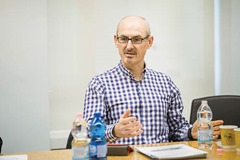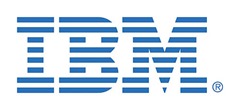Data intelligence and analytics
 IBM Ireland hosted a round table discussion on the use of data intelligence and analytics with a number of practitioners from across a range of sectors. The discussion focused on the benefits of using data to improve decision-making and to develop future opportunities.
IBM Ireland hosted a round table discussion on the use of data intelligence and analytics with a number of practitioners from across a range of sectors. The discussion focused on the benefits of using data to improve decision-making and to develop future opportunities.
How important is data intelligence to your sector?
Fin Goulding
There are two aspects to data for us. The key part is around modelling, pricing and risk management. For example, we are gathering data for an event and are trying to work out who will score the next goal or who will not score the next goal. We are taking in data constantly from our own systems – what our customers are up to – plus our traders are nudging data.
From a business perspective, we are trying to bring in data techniques to structured data. We also have a lot of unstructured data. For example, from facebook, we know you are a Manchester United fan. From twitter, we know you are going to the game. From the transaction systems, we know you have put €50 into your account. The challenge is how do we bring all that together to know you better? We have been using big data to model customers but now we want to get to truly know customers – and that is the journey we are on.
Mick Finn
In the strictest sense of the word, I don’t think we have ‘big data’. We have lots of data but we can still handle the volumes using traditional relational database technologies. However, we do see the importance of data intelligence for the future, with the advent of smart metering.
At present, we get a reading from a domestic customer every two months and with a smart meter we will get one every half-hour – we will see an exponential increase in the amount of data. Overall, the utilities sector is behind other sectors in the use of data intelligence but expectations in the sector are very high, particularly around smart metering and smart grids.
I think for us data is in two parts: ‘big data’ and data analytics. In operating the electricity transmission system, we need to know what is happening second by second so that the lights stay on. We are processing this data constantly – 24/7, 365 days per year.
We are also running the electricity market which relies on timely information. We have quite a scale and volume of data which is growing. For example, with the increased wind energy penetration onto the system, we now have to consider things such as weather data. On the ‘big data’ side, there is huge untapped potential. We are now starting to look at the predictive side of things and that will be our focus going forward.
Seamus Murphy
As a traditional retail bank, we are very advanced in analytics around risk modelling. We are advanced in ‘traditional analytics’ for customer segmentation and propensity modelling, risk modelling, market intelligence and reporting.
A key component of AIB’s strategy is customer experience. To continuously improve the customer experience, we need to understand the customer needs and deliver a consistent service proposition across all our channels – online, mobile and tablet apps, ATM, branch and contact centre.
We use data intelligence to fully understand our customer needs by integrating and analysing 38 million customer events on a monthly basis. We use big data techniques to identify trends and correlations that are a key input in defining AIB’s customer experience strategy.
Enda Murtagh
United Drug operates right across the healthcare supply chain and we are now very much part of the ‘big data’ drive across the sector. From our perspective, we use data in dynamic group planning in terms of delivery of products, with 67 per cent of the Irish market. We are also located in 22 countries around the world. We are trying to integrate all our data into one platform from a management perspective – this has proved very challenging. United Drug’s focus is very much using data to integrate into our partners’ operations in order to better plan what they should manufacture.
The healthcare sector is at the beginning of the ‘big data’ revolution. There is a huge amount of data and the focus is on: “What are the questions people in the supply chain are trying to answer?”
Niall O’Donohoe
From an IBM perspective, along with cloud and the Smarter Cities initiative, data is at the core of our future strategy and that is where we are investing. IBM believes that data is the new natural resource of the 21st century. Organisations in the future will use data in three ways.
Firstly, data will be at the basis of every decision i.e. decisions will be fact-based rather than based on experience or gut-feel. IBM has just announced a new division around Watson, a system for improving healthcare-related decisions. Secondly, data is used as the basis for delivering new products and services – as Seamus has outlined in the financial services sector. Thirdly, the successful enterprise of the future will use data to have a one-to-one relationship with clients, something IBM refers to as systems of engagement. Data is pervasive across all industries and it will become increasing critical to the way we do business.
Have you any good examples where data analytics have been used effectively?
Rodney Doyle
We are working on a smart grid initiative with the National Digital Research Centre at UCC to bring together entrepreneurial initiatives on the island from companies and academics. Already we have had a company approach us for market data to help them develop products that will help customers manage their electricity demand. An example from further afield is the US Department of Energy’s SunShot project which uses data to determine which solar projects installed on the grid are operating most effectively – it is a really good example of data enlivening a whole sector.
One can see examples across a multiple of industries. For example, IBM has taken a healthcare pilot from Canada to University Hospital Cork where we use data analytics to predict infections in premature babies up to 24 hours in advance. The clinicians can then intervene to prevent infants becoming ill.
Another good example is data from Dublin Bus to streamline the traffic system in the city and give buses a green light. A by-product of this project is the real-time ETA information at bus stops, which makes a real impact on the customer experience. Eircom is currently using predictive analytics to reduce churn and improve customer experience.
Fin Goulding
That raises the interesting issue of other people’s data. For example, we would be interested in EirGrid’s weather data as it can influence sporting events. We are already buying a lot of data from different people. Speaking personally, I think I will end up selling my own data at some point. I’ll probably sell my DNA to the drug companies in return for some benefit. In the future, I think we will see people selling their own data – target marketing inversed.
Mick Finn
Another example in the US energy sector is Centrepoint Energy in Texas which uses data to manage the maintenance of its assets. They gather load data on assets such as power lines and transformers and combine it with historical data, manufacturers’ data and weather data. They then maintain their assets in a predictive way rather than on a time-based or reactive schedule. They are effectively using data to predict the lifetime of assets, saving significant costs.
Healthcare is highly regulated and there are issues around the sharing of data. For example, we hold a lot of data from many different partners and where many see the potential of this data is at the market level. We have pharmacy data that helps us to predict the demand for certain drugs but you cannot share that data with certain organisations and it is highly regulated when you can share it. The potential for big data in health is huge but the drive for it across the sector may not be there. There is still a view that each segment wants to hold on to its own data.
Niall O’Donohoe
That is always the key question. Who owns the data? Who owns the customer?
Seamus Murphy
AIB understands the importance of data and analytics and the organisation have invested in a Chief Data Officer. One example of data analytics is listening to the voice of the customer across the social media channels e.g. facebook, twitter. We have an active presence on facebook and provide a successful @askAIB service on twitter.
By listening across these channels we can better understand our customer needs whether it is a question, compliment or a complaint. Data analytics is at the core of this, by integrating all messages across the social media channels and using intelligence and analysis to provide key insight to improve the customer experience. One unexpected challenge we have come across in analysing social media is Irish sarcasm – the tool set cannot understand that!
What challenges are needed to be overcome to get the benefits from data analytics?
Enda Murtagh
A big challenge is to show the value of data quickly, in terms of setting up the platform with the data and to be able to show that in terms of action-based decisions. Senior management are only interested in the outcomes – what can help them make decisions. In United Drug, we have kept this simple and showed real value quickly.
Seamus Murphy
There is a balance for us to strike. We want to be as useful as possible for our customers whether that’s helping them with their budgeting, advising them on the most suitable product, or giving them more functionality to bank through mobile devices. The more data we have about them, the better we understand them and consequently the better we can serve them. However, we need to make sure that this is never intrusive and that the customers’ interests always come first.
Mick Finn
You are going to have to do a certain amount of analytics to keep up with your competitors. But the big challenge for me is to find that inventive use case where your data really differentiates you from all your competitors.
Niall O’Donohoe
You often do not know where the data is going to lead you. Take the supermarket chain example where they found a correlation between the sales of nappies and beer on Friday afternoons, as fathers were sent out to purchase nappies for their babies and picked up a few beers on the way!
One challenge that has changed is storage. In the past, we only kept data for up to seven years because of the cost of storage. With cheaper storage, I would say to CIOs to keep everything. For example, our real-time customer database is 30TB. That would have been a data warehouse a few years ago – storage is no longer an issue.
Rodney Doyle
Data needs to be a partnership between business and IT. If it is only business-led, often it is not practical because of the existing IT infrastructure with separate architectures and databases. Most industries and companies have a huge job to clean up their data and get it structured.
Enda Murtagh
One other challenge is leveraging the technology which is moving so quickly. I think sometimes it is almost better to be behind the curve and learn from others.
Niall O’Donohoe
The biggest challenge is the free movement of data and the security challenges that go with that, particularly for government. Another issue is that organisations need to have an information agenda built into their overall strategy and then build the capability around it to ensure their business objectives are met.
Fin Goulding
We are seeing what we call ‘digital learning’ from data. For example, we analysed the data from basketball matches and found that most matches were won in the last minute. We didn’t know that until we analysed a lot of data.
There is a hybrid between business and IT: the quantum statisticians who do the analysis. Sometimes they are in risk departments or separate BI departments – they have the skills to derive knowledge from data.
What levels of capability exist within your industry for leveraging data analytics?
If we take Google, Yahoo, facebook, amazon or Netflix as pioneers in the area, it’s clear that financial services companies have a lot of catching up to do. These companies have data and analytics at the centre of everything they do and have developed in sectors where they had to innovate or die. If we look at investment banking and consider algorithmic trading, for example, it’s clear that financial services companies can build the capabilities to exploit data by attracting very talented and creative data practitioners.
In the retail banking, innovative thinking hasn’t been applied to data at the same scale but this is undoubtedly changing. The transition from descriptive to predictive to prescriptive analytics will be a challenging one for banks but one that we feel in AIB we will be successful in meeting.
Fin Goulding
We have capability but I am on first name terms with professors at universities, to give you an idea of what we are tapping into. There is a skills gap of the real ‘deep’ data people. I recently read about 150,000 missing globally and 1.5 million in terms of BI and reporting people to meet the demands of organisations now. I think there is a real skills gap but that goes for all tech.
Enda Murtagh
One of the challenges I saw when I was teaching business students in UCD was that they saw IT as people who fix computers. Businesspeople need to understand, and more importantly take ownership of, data analytics. It is not just educating more technology people but educating the businesspeople as to the potential and uses of data analytics.
Niall O’Donohoe
The tools are there. IBM has spent $17 billion over the last eight years buying companies to fill that gap. As for the people, there is a question mark. But I think as more companies take up data, people will see the career opportunities and fill that gap.
The universities need to keep producing mathematicians and, in fact, today you see more and more third level institutes in Ireland offering degrees in analytics thus proving there is an increased demand for this skill set. The real gap for me is the willingness within organisations to really derive insight from their data and to link that back into business goals. Often you don’t know where the data is leading you – it is almost like a leap of faith.
Is there one area senior managers should focus on in order to utilise data analytics to its full potential?
Fin Goulding
It is difficult to choose one thing. But I would say: “Store everything.” Keep all your data even if your business is not ready to make an investment now because they will want that data in the future. I would also move away from the term ‘big’ data as it sounds expensive – I prefer the term ‘data intelligence’.
For us, data governance is an important issue. With the increase in data, we need to look at who the data owners are? Who can make decisions about the data? As already mentioned, what are the inventive use cases for its use that can give us a competitive advantage? There are issues around the life cycle management of data. Traditionally, we don’t delete anything. We also need to look at the tagging and categorisation of data in order to make it useful.
Rodney Doyle
Look closely at the format and standard of data, so that you can bring together structured and unstructured data, analyse it and to clean it up. From a business perspective, you have to be able to show the value of the data. You have also to speak a language that policy-makers and businesspeople can understand – they need to see the real value of data.
Seamus Murphy
New technologies and analytical methodologies are emerging at an incredible rate to meet the evolving data asks and it’s easy to get caught up in this. I think the key is to focus on business outcomes and use whatever tool or technology gets you the answer you need in the shortest time. There probably won’t be a one-size-fits-all solution as we’ve had in the past; it’s more likely to be a combination of tools. Senior managers need to understand this and build teams that are adaptable and multi-skilled.
Enda Murtagh
Make it a business-driven focus rather than an IT focus. An inter-industry collaboration approach will help the sector as a whole but we need to look at who owns the data. The monetisation of the data is a challenge but everyone will benefit from the common good.
Niall O’Donohoe
Apart from the obvious issue of discovering and knowing where your data is and if it is structured or unstructured, the big challenge is for people to see the value in data and that is hard to quantify. How do you sell data within the business? Sell to the CFO that there is value in data? How do you get that initial quick win so that people see the value? Ultimately, in my opinion, big data and analytics are the foundation for any organisation to gain and sustain competitive advantage.
The Participants
Rodney Doyle
Rodney Doyle has been Director of Information Services in EirGrid Group since February 2013. Before this, he held a number of management positions in EirGrid, most recently as the European Market Integration Manager. Rodney is an economist by background and has worked in consultancy and in regulation for the New Zealand competition authority concentrating on utilities and market design.
Mick Finn
Mick Finn is the Data Architect for ESB with a responsibility for management of all data, both structured and unstructured across the ESB group. The role currently resides in the Enterprise Architecture & Technology Group in its corporate IT division. With a background in IT, he has over 20 years’ experience in the energy industry working in a wide range of roles from developer to managing large teams and IT projects.
Fin Goulding
Fin Goulding recently joined Paddy Power as Group CIO, based in Dublin. Prior to this he was the CIO of Sabre Holdings’ offshore Global Development Center in Buenos Aires, Argentina, where he was the CIO of Travelocity Europe and CTO of lastminute.com Fin previously worked in financial services, holding senior leadership positions in First Data Europe, Visa International, HSBC Bank, RBS Bank and Nat West Bank in Europe.
Seamus Murphy
Seamus Murphy is Head of Data at AIB. He is a proven business leader experienced in delivering the strategy and practices to make data a key corporate asset within organisations and is recognised as a key enabler in transforming businesses into data-led organisations. Seamus is experienced in helping organisations to define and implement strategic initiatives to increase revenue, reduce cost and optimise business performance, through the use of data analytics.
Enda Murtagh
Enda Murtagh has been BI Programme Manager at UDGHealthcare (formerly United Drug) since January 2013. He has over 10 years’ experience in the IT industry where he has been responsible for the delivery of multi-country projects, primarily in the realm of business intelligence. Previous to this, he worked for three years as a lecturer in UCD and Smurfit Business School in the areas of MIS and decision science.
Niall O’Donohoe
Niall O’Donohoe is Director, Ireland Enterprise Unit, at IBM. Niall has held a variety of position across sales and marketing in both the Irish and international markets. Previous roles included Territory Sales Manager at the company and Storage Sales Leader in Europe with responsibility for IBM sales into SME businesses in the UK, the Nordics, Germany, Austria and Switzerland. Niall holds a bachelor of business studies degree from the Institute of Technology, Sligo.












